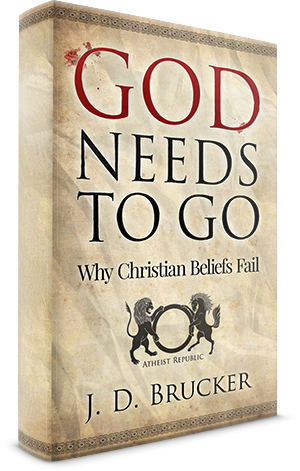
Quite often we hear that atheism is the least-positive force propagated by humanity. It’s also been said that atheism has led to the loss of a countless number of lives; Hitler, Stalin, Pol Pot, and Mao top the list of offenders. Men from the likes of Bill O’Reilly and Dinesh D'Souza are quick to posit this as a serious objection to the lack of a belief in a god; an argument that fails quicker than a Larry the Cable Guy joke. We atheists have faced this question before and we know how to properly answer it, but grow tired of these senseless responses from the Christian Right.
So, I decided to dredge up the latent hypocrisy behind the words of those who suggest that the most violent offences are a result of bureaucratic atheism. The lack of a belief in god doesn’t ask one to wish for bloodshed; that’s a business better suited for religious doctrine. If Christians wish to build a case against atheism beginning with a faulty argument such as that, perhaps they should look into the violent past of Christianity before fallaciously criticizing atheism.
The Slaying of Hypatia of Alexandria (415 or 416 CE)
Hypatia is often viewed as one of the first female philosophers in recorded history. Aside from this accomplishment, she was also considered an intellectual, a mathematician, and an astronomer.
The date of her death is unknown; either it took place in 415 or 416 CE. During this time, strife ran rampant throughout the streets of Alexandria, Egypt. Alexandria’s governor, Orestes, was a great admirer, and her association with him may have led to her death. This is because Cyril, the prevailing Archbishop of the time, became involved in a power-struggle with Orestes. The two would take jabs at one another, and eventually Hypatia was marked for death. It didn’t help that she was a pagan with non-Christian views.
A group of Christians, led by Peter the Lector, marched the streets of Alexandria and found her in a carriage and beat her to death. Socrates Scholasticus wrote the following:
Some of them therefore, hurried away by a fierce and bigoted zeal, whose ringleader was a leader named Peter, waylaid her returning home, and dragging her from her carriage, they took her to the church called Caesareum, where they completely stripped her, and then murdered her with tiles. After tearing her body in pieces, they took her mangled limbs to a place called Cinaron, and there burnt them. This affair brought not the least opprobrium, not only upon Cyril, but also upon the whole Alexandrian church. And surely nothing can be farther from the spirit of Christianity than the allowance of massacres, fights, and transactions of that sort. This happened in the month of March during Lent, in the fourth year of Cyril's episcopate, under the tenth consulate of Honorius, and the sixth of Theodosius.
She’s since become an inspiration to those who choose to deviate from the social norm by pursuing the opposite of the prevailing ideas.
The First Crusade (1099 CE)
This was a dark and dismal period of Christianity. Beginning in 1095, Pope Urban II wished to reclaim the holy land from enemy control. Some have argued the wars were only a retaliatory war effort in response to the loss of the land to Muslims in 1071, but eventually became slightly more religiously-driven. Once it began, there seemed to be no end.
During the first crusade, Raymond D’Aguilers wrote of the siege of Jerusalem in 1099:
Some of our men cut off the heads of their enemies; others shot them with arrows, so that they fell from the towers; others tortured them longer by casting them into the flames. Piles of heads, hands and feet were to be seen in the streets of the city. It was necessary to pick one's way over the bodies of men and horses. But these were small matters compared to what happened at the temple of Solomon, a place where religious services were ordinarily chanted. What happened there? If I tell the truth, it will exceed your powers of belief. So let it suffice to say this much at least, that in the temple and portico of Solomon, men rode in blood up to their knees and bridle reins.
Fulcher of Chartres wrote:
A great fight took place in the court and porch of the temples, where they were unable to escape from our gladiators. Many fled to the roof of the temple of Solomon, and were shot with arrows, so that they fell to the ground dead. In this temple almost ten thousand were killed. Indeed, if you had been there you would have seen our feet colored to our ankles with the blood of the slain. But what more shall I relate? None of them were left alive; neither women nor children were spared.
– History of the Expedition to Jerusalem by Fulcher of Chartres
William of Tyre wrote:
It was impossible to look upon the vast numbers of the slain without horror; everywhere lay fragments of human bodies, and the very ground was covered with the blood of the slain. It was not alone the spectacle of headless bodies and mutilated limbs strewn in all directions that roused horror in all who looked upon them. Still more dreadful was it to gaze upon the victors themselves, dripping with blood from head to foot, an ominous sight which brought terror to all who met them. It is reported that within the Temple enclosure alone about ten thousand infidels perished, in addition to those who lay slain everywhere throughout the city in the streets and squares, the number of whom was estimated as no less.
This was only the first of seven wars waged over the course of 200 years. Many other battles were fought throughout the Middle East, leaving hundreds of thousands killed. Of course, this is not to say the Christian forces weren’t without casualties; they too lost a good number of soldiers. But the Christians were relentless in their efforts, slaughtering men, women, and children as they tore through the holy land. Seen as a valiant effort on behalf of the Christian name, these men who partook in the aforementioned atrocities were revered and honored. Action such as this is everything but noteworthy and respectable.
The Crusades finally came to an end close to the thirteenth century once the Christian forces began to lose significantly, ultimately concluding the holy wars were nothing but an utter failure.
Up Next
Of course, this isn’t the extent of my campaign. Evil deeds done in the name of God ran rampant throughout Europe for an extent of time that lasted far too long. Please follow along as I tackle the Spanish Inquisition and conquests of the America’s in my following blog post.
Photo Credits: '"Hypatia" at the Haymarket theatre. Philammon declaring his love for Hypatia'. Print from the first page of The Graphic, 21 January 1893.































